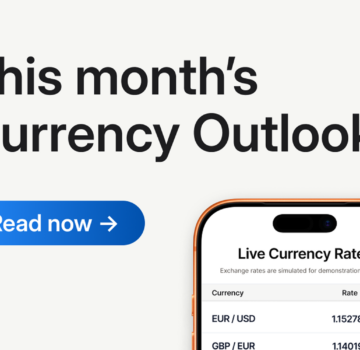Managing business expenses is about more than tracking receipts. It’s about making smart decisions with your company’s money. From financial planning and forecasting to identifying inefficiencies and uncovering opportunities to save, effective expense management gives you visibility and control over how your business spends.
With the right tools in place, expense management isn’t complex. Automating your expense management process can reduce admin, improve compliance, and free up your team to focus on strategy instead of spreadsheets. When everything’s tracked in real time, you gain clearer insight into your organisation’s financial health, so you can move forward with confidence.
Summary:
• What is expense management?
• Manual vs. automated expense management
• Expense management vs. spend management
• Why expense management matters
• How an expense management system works
• What does an expense management system include?
• The role of expense management reporting
• Why multi-currency matters in expense management
• The benefits of an integrated system
• How to choose the right expense management solution
• Best practices for smarter expense management
• What better expense management looks like
• Expense management FAQs
What is expense management?
Expense management is the process a business uses to track, approve, reimburse, and analyse expenditures. That may include anything from employee travel and entertainment to subscriptions, office supplies and cross-border payments.
Expense management usually involves these steps:
Tracking expenses — gathering all those receipts, travel costs, and other business-related spends so nothing slips through the cracks.
Following company policy — making sure every claim lines up with the rules you’ve set, so there’s no overspending or unwarranted expenses.
Getting approvals — sending expenses off to the right managers or team members to sign off on before they’re paid out.
Reimbursing staff — making sure your team gets paid back fairly and on time for any out-of-pocket costs.
Reporting and analysis — looking at the data to spot spending patterns, identify savings, and make smarter financial decisions.
Manual vs. automated expense management
An effective expense management system plays an important role in helping businesses stay financially organised, compliant, and in control of their cash flow. That’s important in a fast-moving global economy.
Despite the rise of digital systems and automation, many businesses still rely on manual tools to track and manage expenses. The 2025 state of expense management report by Findity 1 shows that in 2024, 35% of employees across all markets still use paper-based processes or spreadsheets.
The difference between old-school manual methods and automated software shows how much technology can transform your expense management process.
| Aspect | Manual | Automated |
|---|---|---|
| Data entry | Paper receipts, manual input | Digital capture, automatic data extraction |
| Approval process | Physical forms, slow email chains | Instant notifications, streamlined workflows |
| Expense tracking | Spreadsheet updates, limited visibility | Real-time dashboards, detailed reporting |
| Reimbursements | Manual calculations, delayed payments | Fast and accurate payments with integrated systems |
| Error rate | High | Low |
| Compliance and audits | Manual review of documents | Automated compliance checks and audit trails |
| Employee experience | Frustration with paperwork and delays | Quick and easy digital submissions |
With the right solution, expense management becomes less about chasing receipts and more about making strategic decisions based on accurate and up-to-date data.
Businesses that embrace digital expense management are leading the way in 2025. 2
Expense management vs. spend management
People often use the terms expense management and spend management like they mean the same thing, but they’re different. Expense management deals specifically with the small, everyday costs employees cover while doing their jobs. That could be a coffee on the go, a business lunch with a client, an unexpected change to a flight, or another out-of-pocket expense that needs to be reimbursed.
Spend management is the bigger picture. Managing budgets, enforcing spending policies, administering approvals and analysing spend for cost savings. It includes every expense in the business, from employee overheads to larger, planned payments like vendor contracts, SaaS subscriptions, and purchasing essential materials or equipment. Along with managing budgets, enforcing spending policies, administering approvals.
Think of expense management as one important piece of your overall spend management puzzle. When you bring both together, you’ll get a full, clear view of company spending. That clarity helps spot opportunities to save, improve cash flow, and make smarter financial choices.
OFX Spend Management
made simple
Get better visibility of your finances across your entire business. View every supplier bill, approval history, currency rate and payment status in one place.
Why expense management matters
For growing startups to mid-sized and larger companies that are expanding into international markets, effective expense management is a must. Without a centralised process and system in place, costs can spiral, reimbursements get delayed, and reporting can become unreliable.
A strong expense management system helps businesses:
- Maintain compliance with internal policies and external regulations (such as ATO guidelines in Australia)
- Control costs and optimise cash flow
- Prevent duplicate claims and fraudulent activity
- Reduce the manual burden on finance and admin teams
- Gain visibility across departments, teams, currencies and time periods
When implemented well, expense management improves the overall financial health of your business. It helps you forecast more accurately, plan budgets with confidence, and respond quickly to emerging challenges, from rising supplier costs to currency fluctuations and economic uncertainty.
How an expense management system works
Digital expense management systems take care of the full lifecycle of a business expense, from purchase to reconciliation. Here’s how a typical process works:
- Capture – Employees make a purchase and upload their receipt using an app or web interface. Tools with OCR (optical character recognition) automatically extract relevant data such as date, amount, merchant and currency.
- Categorise – The system applies smart rules or AI to categorise the expense (e.g. travel, meals, office supplies). This step helps ensure consistency in expense tracking and reporting.
- Check – Expenses are matched against company policy. For example, if an expense is over the daily limit or claimed outside business hours, it gets flagged automatically.
- Approve – The expense is routed to the appropriate manager for approval. Automated approval chains ensure nothing is missed and delays are reduced.
- Reimburse – Approved expenses are reimbursed via payroll or integrated payment systems.
- Report – All expense data flows into a real-time dashboard. Finance teams can track trends, forecast spend, identify outliers, and close the books faster.
This streamlined expense management process eliminates the need for manual data entry, follow-ups and guesswork. It reduces the risk of errors and allows your finance team to focus on what matters: analysis, insight and action.
What does an expense management system include?
An effective expense management system typically includes:
- Mobile receipt capture – Staff can upload expenses on the go
- Smart categorisation – AI and custom rules match spend automatically
- Policy enforcement – Automatic flagging of out-of-policy claims
- Approval workflows – Multi-step routing based on amount, department or project
- Multi-currency support – Essential for businesses working across borders
- Spend limits and controls – Set limits by team, project, or cardholder
- Integrated corporate cards – Track card spend in real time
- Accounting software sync – Link directly with Xero, QuickBooks or your ERP
- Real-time expense reporting – See what’s being spent, where, and by whom
- Audit-ready data – Keep everything stored securely and easily exportable for audits
Together, these features make expense management more accurate, efficient and transparent.
Common expense categories to manage
Understanding where your money is going is the first step in improving expense management. Typical expense categories include:
- Travel and accommodation – Flights, hotels, taxis, and mileage
- Meals and entertainment – Client dinners, events, team meals
- Office supplies and subscriptions – Software, stationery, and digital platforms like Zoom, Adobe Creative Cloud and Microsoft 365
- Employee reimbursements – Parking, mobile usage, work-from-home setups
- Professional services – Contractors, consultants, legal or accounting support
- Business materials & equipment – Construction machinery, materials & tools
- Cross-border payments – Payments made in foreign currencies or to overseas suppliers
Each category may have different approval requirements or tax implications, which is why an expense management system that can tag, sort and report by category is so valuable.
The role of expense management reporting
A major benefit of a digital expense management system is real-time, flexible reporting. Rather than waiting until month-end to uncover issues, your business can track spend continuously. Good expense management reporting helps finance teams:
- Monitor team spend across departments or locations
- Spot inconsistencies such as duplicate claims or policy violations
- Track supplier payments and vendor performance
- Forecast budgets based on actual historical data
- Generate reports for tax, compliance, or leadership meetings
With clear reporting, you will be better equipped to make decisions about cost-saving initiatives, renegotiate supplier contracts, or adjust project budgets proactively.
Why multi-currency matters in expense management
If your business operates internationally, managing expenses in multiple currencies adds another layer of complexity. Without a dedicated multi-currency account, you may face:
- Hidden FX margins – Banks often add extra fees to exchange rates
- Slow international transfers – Cross-border payments can take days
- Double conversions – Funds are sometimes converted multiple times unnecessarily
- Poor visibility – Hard to reconcile multi-currency payments in standard systems
Combining your expense management system with a multi-currency account like the OFX Global Business Account can simplify this process. You can receive, hold, and pay in over 25+ currencies, automate currency conversion, and avoid unnecessary fees.
The benefits of an integrated expense management system
By connecting your expense management tool directly with your existing accounting software, you cut down on manual data entry and gain real-time visibility into your company’s financial position. 82% of organisations3 now list integration as a key priority when selecting an expense management solution.
Pairing your expense management process with the OFX Global Business Account helps unlock new levels of efficiency. Benefits include:
- Real-time visibility across currencies, cards and departments
- Automated reconciliation – Spend data syncs with your accounting software
- Smarter FX management – Lock in rates or set target conversions
- Easier approvals and policy control – Spend caps by card or team
- Audit-ready reporting – All spend data stored and exportable in seconds
How to choose the right expense management software solution
Not all platforms are created equal. When comparing the best expense management software, consider:
- Ease of use – Can your team pick it up quickly?
- Mobile access – Are there apps for submitting on the go?
- Multi-currency support – Does it support the currencies you need?
- Integration – Will it connect with your accounting and banking tools?
- Security and compliance – Is your data protected and audit-ready?
- Scalability – Will it grow with your business?
- Customer support – Do you have help when you need it?
A good solution should reduce your admin load, improve accuracy, and give you insights, not just data. With OFX, real humans are available 24/7 to answer your questions. You can call or email us anytime.
Looking for a better way to manage
your business expense?
Best practices for smarter expense management
To get the most from your expense management system, follow these tips:
- Automate what you can
Manual tasks slow your team down and introduce unnecessary risk. Look for opportunities to automate key parts of the expense management process, such as expense approvals, reimbursements, and expense categorisation. Automation not only speeds things up but also reduces errors and creates a consistent audit trail for reporting and compliance.
- Set clear, simple policies
Clear expense policies reduce confusion and make it easier for employees to make the right decisions. Define what types of expenses are eligible, set spending limits by role or region, and make sure your policy is accessible and easy to follow. A well-communicated policy creates consistency across teams and helps your expense management system run as smooth as it can be.
- Use corporate cards to track spend in real time
Corporate cards integrated with your expense management system allow you to monitor business spend as it happens. Instead of waiting weeks for receipts and reconciliations, you get a live view of team expenses, which makes it easier to stay within budget and respond quickly to anomalies or overspending.
- Review expense reports regularly
Expense management reporting shouldn’t be a once-a-quarter activity. Regular reviews of expense data help you spot trends early, identify unnecessary costs, and make data-driven decisions. Use your reporting tools to compare spend by team, location or category, and uncover areas where you can negotiate better rates or reduce waste.
- Train your teams to use the tools
Even the best expense management software is only as effective as the people using it. Offer training and support to ensure employees understand how to submit expenses correctly, use mobile apps, attach receipts, and follow approval workflows. When your teams are confident using the system, you’ll see fewer errors, faster processing times, and stronger compliance.
By embedding expense management into your daily operations, it becomes second nature and not an end-of-month scramble.
What better expense management looks like
Expense management is about improving the way your business runs. From more accurate budgets to faster payments and smarter decision-making, a good system gives you the insight and agility to grow confidently.
OFX offers a unique solution that goes beyond the basics. It’s a single platform that handles international payments, currency exchange, and business spend management. With OFX’s Corporate Cards, handling cross-border expenses is simple. With strong regulatory backing, businesses can feel secure and confident with tools to manage money across borders including:
- Global Business Account: Manage funds in over 30 currencies, allowing you to simplify your operations across borders.
- Corporate Cards: Issue physical or virtual cards instantly to your team and track expenses in real-time.
- Spending policies built-in: Issue employees cards with spending policies built-in and prevent unauthorised spend. Control everything from spend limits, expense category, merchants to locations.
- Integrated expense tracking: Sync employee card transactions with the platform, enabling automatic merchant identification further reducing the risk of unauthorised expenses.
- Automated receipt capture: Snap a photo of your receipt with our in-app receipt capture and OCR data extraction tools. Automatically populate info and submit for approval.
- New intelligent AI receipt matching: Upload an expense or copy the receipts email and send it in via email. Our smart AI will automatically attempt to match to the card transaction and fill out all the expense details.
- Cashflow visibility: With 2-way sync to QuickBooks and Xero accounting software, the data flows between the tools. This means you only need to complete tasks once, in one place, so it’s easier to get real-time cash flow visibility across platforms.
- Mobile App Access: Manage your expenses on the go with the OFX Business App, ensuring you’re always in control.
- 24/7 Customer Support: Access to around the clock phone support from real people, a dedicated account manager and help onboarding.
Enjoy the benefits of smarter, more efficient expense management with OFX. Take a virtual tour and sign up for a free trial to OFX Full Suite today to take control of your business finances.
Expense management FAQs
What exactly is expense management?
Expense management is how businesses track, approve, reimburse and analyse employee and company spending. It covers everything from travel and meals to office supplies, helping companies keep control of cash flow and stay compliant.
How is expense management different from spend management?
Expense management focuses on day-to-day employee expenses, like business lunches or travel reimbursements. Spend management is broader. It includes all company outflows such as vendor contracts, subscriptions, and capital investments.
Why should my business automate expense management?
Automation cuts down on manual admin, reduces errors, speeds up approvals, and gives you real-time visibility into spending. This means your finance team can spend less time chasing receipts and more time making strategic decisions.
Can an expense management system handle multi-currency expenses?
Absolutely. For businesses working across borders, multi-currency support is essential. Modern systems, especially when paired with tools like OFX’s multi-currency corporate cards, simplify managing foreign currencies, reducing fees and delays.
What are common expense categories that I should track?
Typical categories include travel and accommodation, meals and entertainment, office supplies, professional services, employee reimbursements, and cross-border payments. Tracking by category helps with budgeting and compliance.
How does an automated expense management system improve compliance?
These systems automatically flag out-of-policy expenses and create audit-ready records, helping prevent fraud and ensuring adherence to internal policies and external regulations.
How quickly can employees get reimbursed with an automated system?
With automation and integrated payment systems, reimbursements happen within days. That’s much faster than manual processes, as that way it can take weeks.
How do corporate cards help with expense management?
Corporate cards integrated with your expense platform give you real-time visibility of spending, simplify expense tracking, and reduce manual data entry. They also allow you to set spending limits and controls.
What should I look for when choosing an expense management solution?
Look for ease of use, mobile accessibility, multi-currency capabilities, integration with your accounting software, strong security, scalability, and responsive customer support.
How does OFX support better expense management?
OFX combines international payments, currency exchange, and business spend tools in one platform. With multi-currency corporate cards and strong regulatory backing, OFX helps businesses manage expenses seamlessly across borders, reduce fees, and improve financial control.
Sources:




